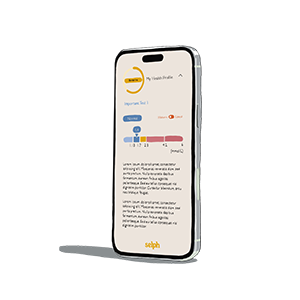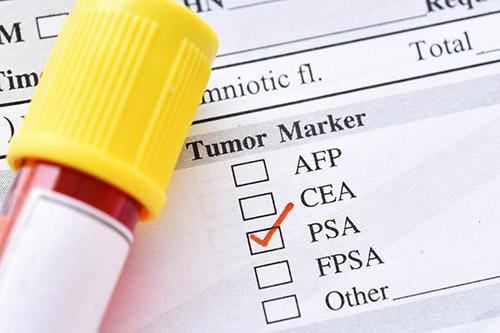Personalise your test
Add to your test
2 add-ons availableChoose how to collect your sample
5 optionsFinger-prick blood collection
Total price:
£55.00
Includes our
PSA Blood Test
Use our at home PSA test kit to collect your blood sample and send it to our NHS-testing lab. In under a day we'll check your PSA levels and send you an easy-to-understand doctor's report about your risk of prostate cancer.
Why you should take a PSA Test
- PSA blood tests help to identify if you're at higher risk of having prostate cancer. This is important as prostate cancer often causes no symptoms.
- Taking a PSA test increases your chances of picking up prostate cancer before it has spread and reduces the chance of dying from prostate cancer by about 30%.
- Guidelines support PSA testing from age 45+ (or 40+ if high-risk - black ethnicity or family history)
Signs you should take a PSA test - prostate cancer symptoms
Most prostate cancers do not cause any symptoms until they are large or have spread - this is why it's important to check your PSA even when you have no symptoms.
Symptoms of prostate cancer include:
- Difficulty starting urination.
- Weak or interrupted flow of urine.
- Urinating often, especially at night.
- Trouble emptying the bladder completely.
- Pain or burning during urination.
- Blood in the urine or semen.
- Pain in the back, hips, or pelvis that doesn’t go away.
- Painful ejaculation.
What do the PSA blood test results mean?
Your PSA level needs to be interpreted in the context of your age because PSA naturally goes up as you get older due to the prostate increasing in size. The National Institute of Clinical Excellence (NICE) have suggested PSA thresholds for specific ages to trigger further investigation of the prostate (e.g. with an MRI scan).
| Age | PSA Threshold (μg/L) |
| 40 - 49 | >2.5 |
| 50 - 69 | >3 |
| 70 and over | >5 |
However, other guidelines recommend that all men with a PSA above 3μg/L undergo further investigations. We suggest that anyone with a PSA level over 3μg/L discuss this with their doctor.
A high PSA level doesn't mean you have prostate cancer but it does make prostate cancer more likely and you'll generally be advised to have a scan of the prostate to investigate further.
How accurate is a PSA blood test?
The PSA blood test is a test to assess your risk of having prostate cancer. Your risk of prostate cancer will depend on how high your PSA level is.
If your PSA level is between 3 - 10 μg/L, your risk of prostate cancer is about 25%.
If your PSA level is over 10 μg/L, your risk of prostate cancer is over 50%.
However, it's important to bear in mind that about 1 in 7 men can have a normal PSA level and later be diagnosed with prostate cancer. This is why it's so important for men to monitor their PSA level regularly rather than just as a one-off.
5α-reductase inhibitors can falsely lower PSA levels so you need to adjust your result (doubling your PSA) if you take this medication.
How it works

Do your PSA test
You'll get your kit next-working day.
Collect your blood sample at home and send it back to our UKAS-accredited lab for PSA analysis.

Get rapid results
Once the lab have your sample, you'll get your PSA result same-day (over 90% of tests).
Your result includes the PSA level and a doctor's report to explain what it means for your prostate cancer risk.

Get support
We're here to support you every step of the way.
We get that doing a PSA test can be a bit daunting - our doctors and admin team are always just a phone-call away if you need any help.
What's tested in the PSA Blood Test?
Our PSA blood test checks for prostate specific antigen levels in your blood. High PSA levels can be a sign of prostate cancer and should be followed up with a prostate scan.
In addition to testing your PSA level, we'll also test your free PSA level and Free-to-Total PSA ratio if your PSA level is borderline high, at no extra cost. These markers give you more information on your prostate cancer risk.
Prostate specific antigen (PSA)
Your PSA level can help you understand your risk of prostate cancer and guide further testing.
Free PSA
If your PSA level is between 2.0 - 10μg/L we'll check your free PSA level to get more information on your prostate cancer risk
Free PSA to Total PSA ratio
If your PSA level is between 2.0 - 10μg/L we'll calculate your free to total PSA ratio to help guide further actions by your doctor.
PSA Blood Test FAQs
If you're under 40 years of age your risk of prostate cancer is extremely low and we don't have any research to suggest a benefit in terms of predicting your future risk of prostate cancer when testing at this age.
In order to make your PSA blood test as accurate as possible, it’s important to prepare for it by:
- making sure you’ve not had a urinary tract or coronavirus infection (or vaccination) in the previous 6 weeks
- avoiding ejaculation for 2 two days beforehand
- avoiding vigorous exercise, particularly cycling, for the previous 2 days
- waiting at least 6 weeks after a prostate biopsy or cystoscopy before testing
How often you should take a PSA blood test depends on your last PSA level and if you're at higher risk of prostate cancer (black ethnicity or family history of prostate cancer for example).
- If your PSA level is 1-3 μg/L or you're at higher risk of prostate cancer, guidelines recommend checking your PSA every year.
- If your PSA level is less than 1 μg/L and you're not at higher risk of prostate cancer, then guidelines recommend checking your PSA level every 2 years.
Total PSA actually includes two different forms of PSA. PSA can be bound to other proteins in the blood or it can be ‘free’, meaning that it’s not bound to other proteins.
Free PSA levels are often higher with non-cancerous conditions of the prostate and lower in those with prostate cancer.
We routinely measure free PSA and the ratio of free to total PSA in people who have a PSA of between 2.5 - 10μg/L because it provides more information on prostate cancer risk.
- If your PSA level is 2.5 - 4 μg/L then a normal Free:Total PSA ratio is >0.19.
- If your PSA level is 4 - 10 μg/L then a normal Free:Total PSA ratio is >0. If your Free:Total PSA ratio is above these cut-offs then it makes prostate cancer more likely compared to a ratio below the thresholds.
People assigned male at birth will have a prostate and this is not removed during gender-affirming surgery. Therefore trans women are at risk of prostate cancer. However, testosterone lowering therapy can reduce the risk of prostate cancer but it can also falsely lower PSA levels, making them difficult to interpret. Prostate Cancer UK has useful information about the risk of prostate cancer as a trans woman.
Still have questions?
If you have any questions, we're here to help. Our customer service team is hands-down the best you'll ever deal with. They're smart, friendly, knowledgeable and will get back to you in a flash.
We've got the stats to back it all up.
When it comes to health, you want to know you’re in safe hands. We’ve got decades of experience, and we’ve got the stats to prove it.
20+
Years in healthcare
65,000+
5 star reviews

1 million+
Happy customers
2 million+

Our Privacy Promise
Your health is yours. It's personal. That's why we're committed to keeping your data safe and secure. Here's how we do it:
See our Privacy Policy and our Terms of Service for more info.






